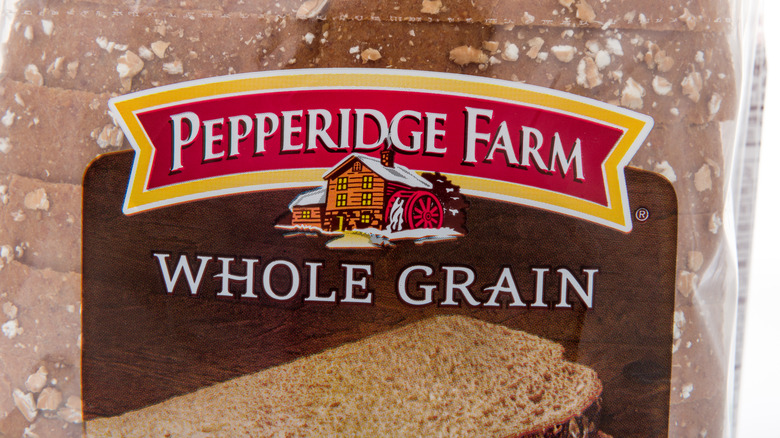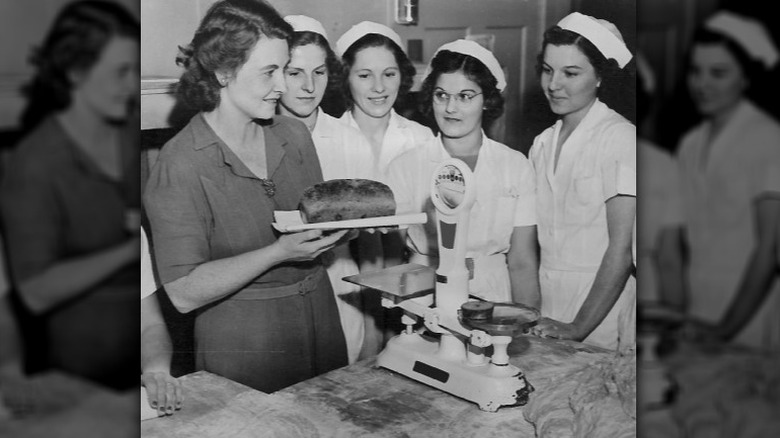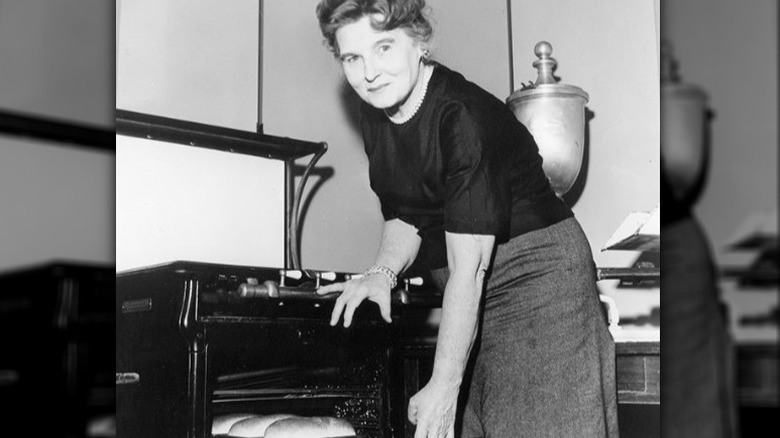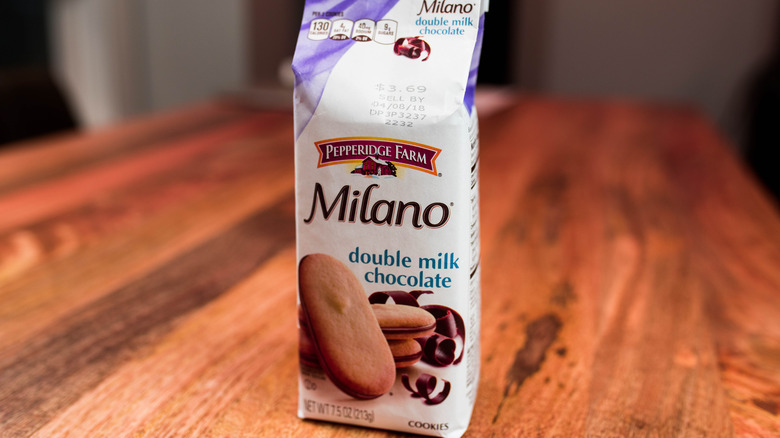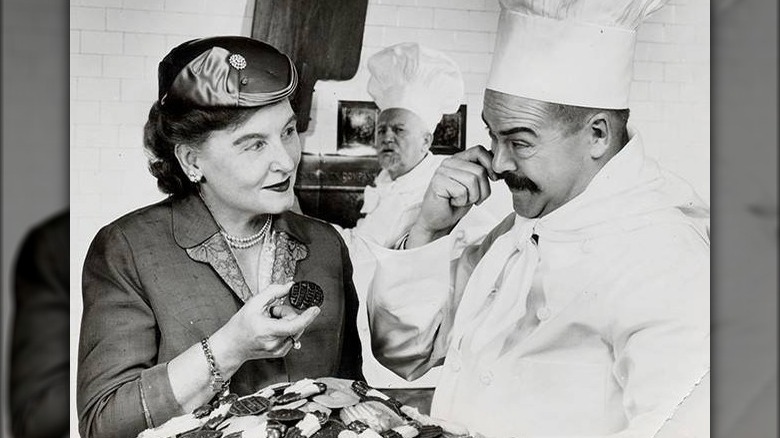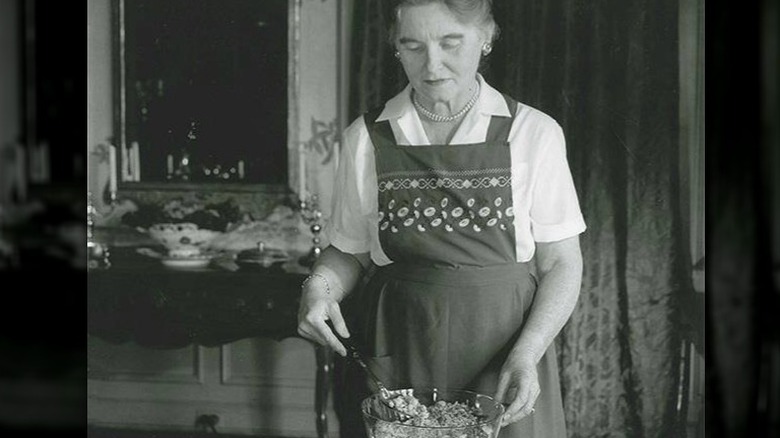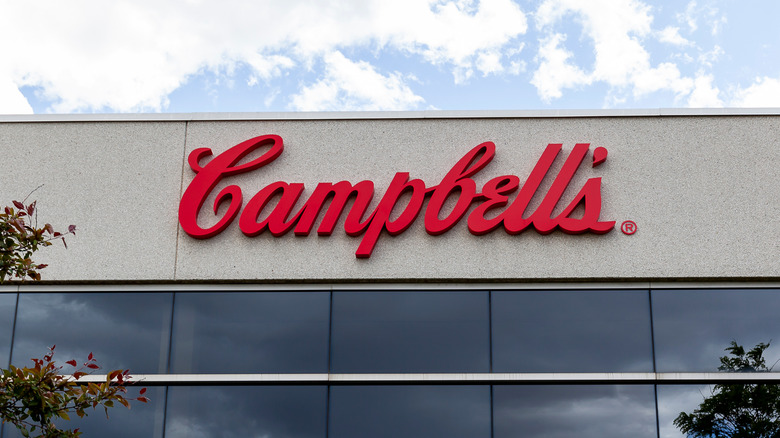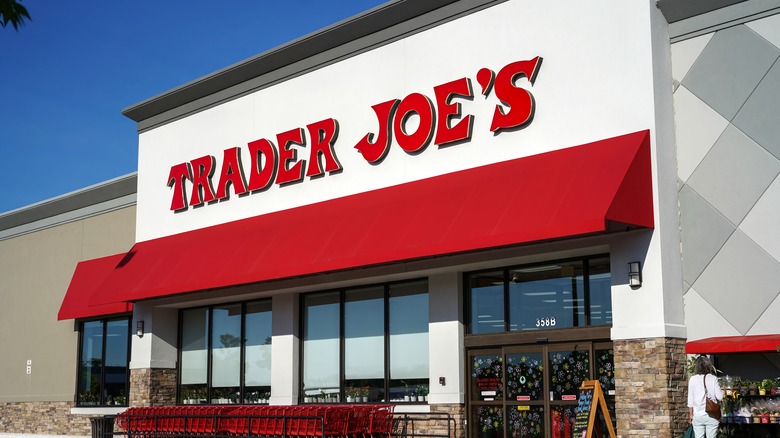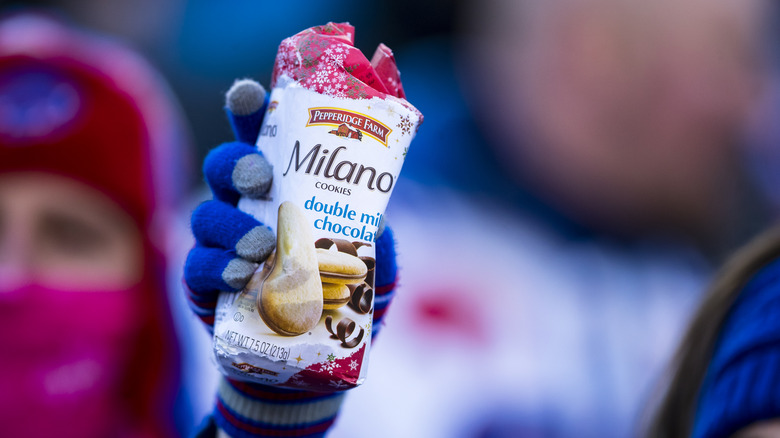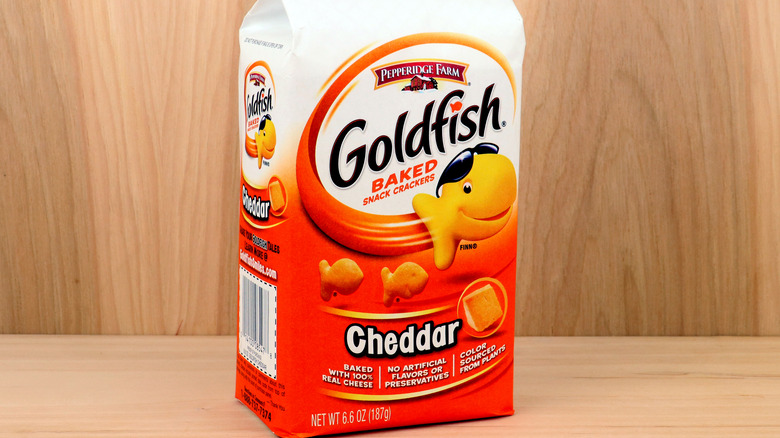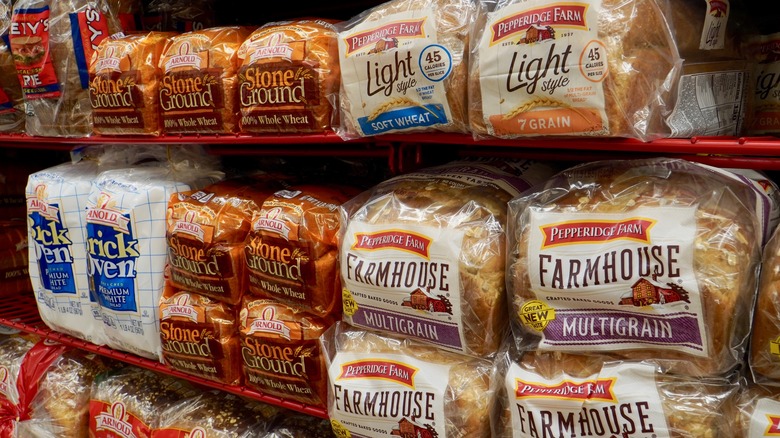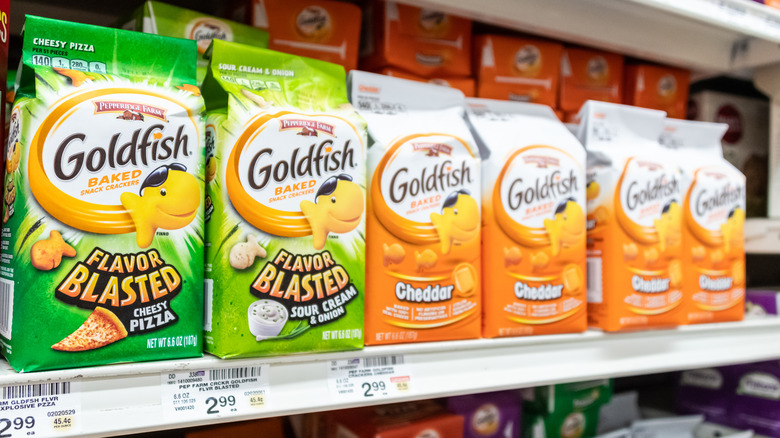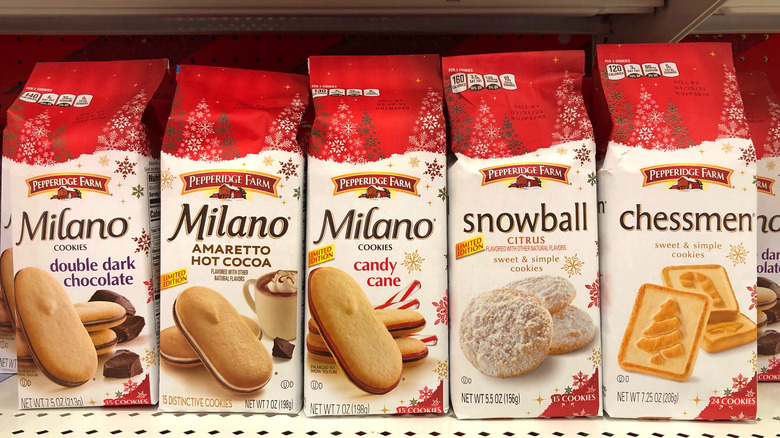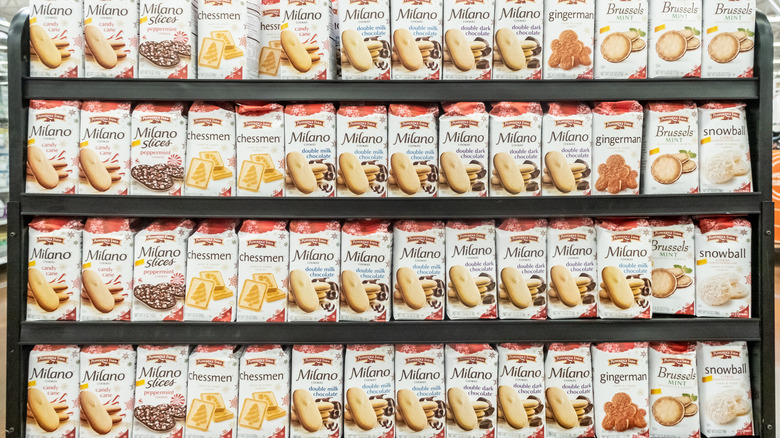The Ultimate Guide To Pepperidge Farm
You know Pepperidge Farm, right? Of course you do. The folks at this iconic American baking brand are responsible for some of your favorite snack foods, including those delicious and delicate Milano cookies, as well as the kid-favorite (and adult-favorite, too — who are we kidding?) snack that smiles back — Goldfish. Those who have explored the brand's offerings a little further than the cookie and cracker aisle are familiar with the company's line of breads and baking products like ready-to-use puff pastry dough. But even if you're familiar with Pepperidge Farm's entire product line, are you familiar with the story behind the farm?
While the brand's red logo featuring a snow-covered cabin and cheery red mill wheel is a popular staple in many a pantry, Pepperidge Farm and even that childhood favorite, Goldfish, are older than you might think. The brand is nearing its centennial birthday, and it all started with a dedicated mother and some bad bread.
Pepperidge Farm was founded in 1937
Margaret Rudkin, the founder of Pepperidge Farm, was born in 1897 in New York City (via Connecticut Explored). She was valedictorian of her class, studied math in college, and worked on Wall Street early in her career. When she wed her husband, Henry, Rudkin settled into her role as his wife. A year later, she became a mother. However, she did not leave her smarts and scrappy attitude at the office.
In 1929, as the Great Depression was looming, Rudkin was dealing with a bevy of personal issues, including Henry's involvement in a polo accident that caused him to be out of work for six months. The lack of income put a strain on the family's finances. At the same time, her son began experiencing asthmatic attacks. The cause, according to the family doctor, may have been due to the boy consuming commercially processed foods, such as bread. Seeing an opportunity, Rudkin began baking bread at home. Within a few years, she founded Pepperidge Farm in 1937.
Pepperidge Farm wasn't an instant success
If you look at Pepperidge Farm's success and its consistent appearance in grocery stores, gas stations, and pantries, you might assume that Margaret Rudkin's success came easily and that the brand was an instant hit. However, it's worth noting that, while Rudkin began baking her homemade bread in 1929, it was still eight years until Pepperidge Farm got off the ground as a viable business.
So what was Rudkin up to during that time? As Investor's Business Daily describes, she was learning to how to bake as well as how to run a business. Despite her later success, Rudkin didn't automatically know how to bake an amazing loaf of bread. Apparently, her "first loaf of bread should have been sent to the Smithsonian Institution as a sample of Stone Age bread, for it was hard as a rock and about 1-inch high." It took a few rounds of trial and error before she happened across a recipe for bread that was good enough to try selling at the local grocery stores.
Pepperidge Farm was a real place
When Margaret Rudkin began looking for a name for her new business, the choice was easy — name it after the family farm. Yes, Pepperidge Farm was a real place in Fairfield, Connecticut. After Rudkin married Henry in 1923, the two moved away from their hometown of New York City for the quieter life of the Connecticut countryside. Here, they had purchased a 123-acre farm that became Pepperidge Farm (via Connecticut Explored).
The farm got its name from a Pepperidge tree on their property. The expansive working farm kept the family busy with its 500 apple trees and a flock of turkeys, but life wasn't too rough. The couple commissioned a European craftsman to design and construct their English Tudor farmhouse, which includes a 12-horse stable, huge garage, stone exterior, and gabled roof. So, no, the rustic mill house you see on the Pepperidge Farm logo isn't the one in which they lived. You can actually see their posh home, or at least photos of the exterior, as the property went on the market in 2020 for $2.45 million (via Regency Real Estate).
Pepperidge Farm's cookies boast a European influence
Sure, Pepperidge Farm may sell chocolate chip cookies, but these are hardly your all-American baked goods. When the company first began selling cookies, Margaret Rudkin was adamant that they reflect the high level of baking she'd witnessed in Europe.
In an interview with Slate in 2012, Pat Callaghan, the company's president at the time, stated that Rudkin decided to expand the product line to include cookies in 1951. However, her first attempts were just as lackluster as her first loaf of bread. So, Rudkin headed to Europe to find cookies that were worthy of her customer base. She came across a cookie manufacturer in Belgium and fell in love with their recipes. She went on to negotiate a contract that would allow her to use them as her own. (And, if you're wondering, that cookie manufacturer was Delacre and the brand is still in business.) In 1955, a line of cookies debuted in stores and was packaged in the now-famous white bags.
Pepperidge Farm still sells three of its OG cookies
When Pepperidge Farm introduced its European-inspired cookies to the public in 1956, it offered six varieties. According to Slate, the cookies were named Biarritz, Bordeaux, Brussels, Venice, Dresden, and Capri, and, as the Naples Daily News later reported, each was seemingly named after famous and popular destinations in Europe.
The Milano cookie, while arguably one of Pepperidge Farm's most recognizable varieties, didn't come along until 1957 when the brand was selling the Naples cookie, which was topped with a layer of chocolate. When these cookies were shipped to the South, the chocolate had a habit of melting. The brand solved the issue by topping each cookie with another one, thus preserving the chocolate and creating the Milano. Today, you can still buy three of the company's OG cookies, including Milano, Bordeaux, and Brussels. Pepperidge Farm describes its Bordeaux cookies as a "caramelized crisp," while the Brussels cookies feature a thin layer of dark chocolate between two thin cookies.
Margaret Rudkin's cookbook set records
Who better to teach you how to bake bread than Margaret Rudkin? It's not surprising that she wrote a cookbook later in her career, or that it was such a hit. Rudkin's "Pepperidge Farm Cookbook," published in 1963, became the very first cookbook to land on the New York Times best-seller list (via the New England Historical Society).
Rudkin's cookbook wasn't just a selection of recipes and bread tips, though. She also included stories about her life and the founding of Pepperidge Farm. Additionally, there was a section that discussed her expansive antique cookbook collection. The notable collection included a 15th-century cookbook that the Pepperidge Farm employees purchased for her on the company's 20th anniversary in 1957; they each donated a dollar to the gift fund. The notable cookbook inspired her to include modern updates for ancient recipes in her own cookbook. The collection can be found in Southport, Connecticut, at Pequot Library.
Margaret Rudkin was before her time
Margaret Rudkin saw a great deal of success in a time when women were expected to be homemakers and mothers. As one Taste article describes, Rudkin was ahead of her time as she plowed forward into the world of business, even if that business was based on the domestic art of baking. She also encouraged other women to do the same.
In the 1940s, Rudkin vocally and adamantly encouraged other women to find their spots in the workplace. She hired many female employees, offering them hours that could fit their busy lifestyles. Single women could work in the morning and tend to their other life responsibilities later in the day. Married women could work shifts after the school day when older children could babysit their younger siblings. Rudkin also noted how the skills of a housewife frequently overlap with the skills needed in the food industry, including the "knowledge of how to buy well, use food properly and prevent waste, maintain cleanliness, routine, and system." She also stated that working women made great mothers, were "marvelous to work with," and just as capable as men.
Campbell's acquired Pepperidge Farm in 1961
By 1960, Margaret Rudkin had grown Pepperidge Farm into a mammoth brand generating $1.3 million in profits and $32 million in sales each year. This is when she decided to sell the company to Campbell Soup Company (via Taste). At the time of the sale, Pepperidge Farm offered more than 50 different products. Rudkin remained involved in managing the brand and was Campbell's first female board member.
In a 2011 release, Campbell's chief operating officer at the time said that the Pepperidge Farm acquisition was one of the most "strategic" that the company had ever made. In 2010, Pepperidge Farm had reached annual sales of $1.3 billion, with a product line that includes nearly 600 items. At the time, the brand also boasted that Goldfish crackers had become the leading "wholesome snack for kids" and was one of the top two cheese crackers on the market. Additionally, 28 million people consumed Milano cookies that year and Pepperidge Farm's swirl bread was No. 1 in its segment, claiming a 40% share of the sweet bread market.
Pepperidge Farm fueled the astronauts
Once you've conquered the bread aisle at the grocery store, where do you go next? For Pepperidge Farm, the answer was the moon. As The Tuscaloosa News reported in 1971, the Apollo 14 moon mission that kicked off on January 31 would include three varieties of Pepperidge Farm bread — rye, white, and cheese. The white and rye bread were nearly the same options that could be bought at the grocery store; they were just baked in special pans to reduce volume and give the bread a square shape. The cheese variety was designed with space travel and the astronauts in mind, and as a way to break up the sandwich monotony. For their first meal, the astronauts would be given ham and cheese sandwiches made with rye bread. The sandwiches were frozen and would be tucked into their spacesuit pockets to thaw by the time they reached space. Oscar Mayer supplied the ham.
This wasn't Pepperidge Farm's first foray into space, though, as the same bread was supplied during the Apollo 13 mission. The astronauts were able to create a true picnic in space by making a variety of sandwiches with the bread, including tuna salad, jelly, cheese, and peanut butter.
Pepperidge Farm vs. Trader Joe's
Pepperidge Farm's past hasn't consisted of just wholesome housewives baking bread and patriotic trips to space. The brand has gotten into its fair share of drama in more recent history, including a court battle with Trader Joe's in 2015, per CNN. The object of the dispute was the brand's Milano cookies.
In December 2015, Pepperidge Farm filed a complaint and accusation against Trader Joe's. The brand stated that Trader Joe's created a rip-off of the Milano cookie and was banking on selling it based on the reputation Pepperidge Farm had already built up for the tasty treats. Indeed, Trader Joe's Belgian chocolate-filled cookies did share a lot of similarities with Milanos, including many of the same ingredients and similar packaging. In 2016, a settlement was reached between the two companies, though the details were not released. Since then, Pepperidge Farm has also been in court battles related to misclassifying employees (via Bloomberg Law).
Pepperidge Farm cares about sustainability
Pepperidge Farm places a lot of stock on sustainability, as can be seen from Campbell's 2022 Corporate Responsibility Report. In the report, the company announced an array of efforts to produce the snacks in a more eco-friendly and sustainable manner.
For example, all Pepperidge Farm signature paper bags — like those that are used for both Milano cookies and Goldfish crackers — are now recyclable. Instead of using trucks and a lot of fossil fuels to transport flour to its Ohio Goldfish bakery, the company now uses a tube to transport the flour between the bakery and the nearby flour mill. This allows more than 50 million Goldfish to be produced daily without the need for trucks. Nearly 10% of the company's electricity now comes from renewable sources and Pepperidge Farm's sustainability commitment aligns with the Paris Agreement. The brand's sustainability efforts also include reducing food waste and helping those in need; the company donated $54.2 million in food and funds to worthy causes in 2021 alone.
Goldfish are Swiss
Right after Campbell's acquired Pepperidge Farm, Margaret Rudkin, who was still managing the company, introduced Goldfish crackers in 1962. However, Goldfish isn't an American invention and they go back a lot further than the 1960s.
According to Campbell's, Rudkin discovered Goldfish during the same trip to Europe that she took for cookie research more than a decade prior. There, she found a Swiss manufacturer already making the snack food, which had originally been created as a gift for the creator's wife who was a Pisces. Surprisingly, the original Goldfish were not cheddar cheese-flavored, though, even though that's the most familiar flavor today. Instead, the introductory options included lightly salted, barbecue, smoky, pizza, and an unspecified cheese flavor. The cheddar cheese flavor that's now oh-so-popular was introduced in 1966. Similarly, the first Goldfish did not have the smile that we all know today; that was added in 1997.
Pepperidge Farm makes a point to be premium
If you think about Pepperidge Farm and its many fan-favorite products, it's easy to see the underlying high quality that touches everything the brand does. According to a 1987 article in The Hour, Pepperidge Farm considered itself a part of the "adult cookie business." Richard A. Shea, the company's president at the time, said the brand's cookie line suffered previously when it attempted to break into a more kid-friendly market, like when it introduced a line of Star Wars-themed cookies. Shea is quoted as saying, "We got our clocks cleaned. People expected premium and all of a sudden, we did something that didn't fit our personality."
So how was Pepperidge Farm putting this dedication to premium quality into action in the 1980s? At the time, the article reported, the brand sold the most expensive pizza in stores. What set this pizza apart from others was that it was made with natural cheese and croissant dough. Additionally, the brand began adding more chocolate chips to its cookies.
In 2007, Pepperidge Farm launched a social media platform
While Pepperidge Farm had been successful with bread, cookies, and crackers, there was one industry in which it didn't have quite as much success: social media. In 2007, the company launched Art of the Cookie, a website where women were intended to "improve their social lives," per The New York Times. According to Jezebel, the platform encouraged women to make connections and then to send those connections what was essentially a weekly newsletter filled with news, stories, and photos.
Pepperidge Farm poured millions of dollars into the endeavor, but it didn't quite pan out. The website no longer exists, but that hardly means the brand has given up on inventive ways to market its products through social channels. In 2017, the brand teamed with Chatbooks with an endeavor aimed specifically at women again (via Pepperidge Farm). This time, they encouraged women to savor their "me" time by eating cookies, and sharing holiday moments and hacks with Chatbooks and Pepperidge Farm on social media.
The 2020 Milano cookie shortage
In 2020, the world experienced a Milano cookie shortage. Right before the holidays, Pepperidge Farm announced that Milano and Chessmen Butter Cookies would be in short supply, as Insider reported. Pepperidge Farm had increased production of Goldfish crackers and, since none of the cookie manufacturing is outsourced, the brand simply didn't have the bandwidth to make both the Goldfish and the cookies. Pandemic-related labor shortages added to these difficulties, as did increased demand for cookies overall. Today reported that in fall 2020 alone, demand for Pepperidge Farm products had increased nearly 10%.
Demand for cookies in general increased in 2020, Today also shared, noting that overall demand had risen by 25% in mid-2020. At the time, 20% of Americans ate more than three cookies per day, on average. More than 30% said they ate up to 42 cookies per month and 15% said they consumed more than 60 monthly.
Pepperidge Farm is constantly new
While Pepperidge Farm may be an old brand, it's always coming out with new products or new takes on old favorites. In August 2022, Goldfish partnered with Dunkin' to release a new, limited edition Goldfish Dunkin' Pumpkin Spice Grahams cracker, per Pepperidge Farm (via Cision). The result, as one Mashed review noted, is "definitely worth a taste," even though the flavor profile trends more toward pumpkin spice, cinnamon, and nutmeg than it does donuts.
Also in 2022, Goldfish and Old Bay released a summer-only snack, Old Bay Goldfish, which came packaged in an adorable bag that was meant to look like an oversized Old Bay seasoning container. CNET had nothing but good things to say about the flavor combo, stating it's "darn-near close" to being worth all the hype.
Regardless of what Pepperidge Farm comes up with next, it's just about guaranteed it'll channel the premium quality that Margaret Rudkin imbued in her brand from the start. From her carefully formulated bread recipe to the European-inspired cookies and Swiss snack that smiles at you, Pepperidge Farm products are produced with quality in mind.
